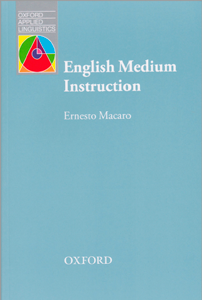English Medium Instruction
English Medium Instruction
by Ernesto Macaro
OUP 2018
978-0-19-440396-2

In English Medium Instruction, Ernesto Macaro surveys what he describes as a neglected field, with wide gaps in knowledge, in research and in the provision of norms of good practice. The book traces the rapid growth of EMI – English Medium Instruction – over recent years, claiming that it represents for education ‘a transformation, the like of which it has not experienced for many decades’.
Macaro is the founding Director of the Centre for Research and Development on English Medium Instruction at the University of Oxford and, as such, possibly uniquely placed to provide a comprehensive survey of the expanding field of EMI. He points out that the concept of EMI is elusive and may mean different things to different people and in different places, with ‘few attempts … in the literature to define … what is actually being talked about’. Before devoting the entire first chapter to this difficulty of definition, Macaro helpfully gives his own on the first page of the introduction: ‘the use of the English language to teach academic subjects (other than English itself) in countries … where the first language of the majority of the population is not English’.
While many readers may think EMI is just an alternative name for CLIL (Content and Language Integrated Learning), as used here it is an umbrella term which includes CLIL but also various other educational contexts. Macaro points out that the history of teaching through the medium of a language which is not the L1 of all the students can be traced back to classical times, where Roman children were educated through the medium of Greek, seen as the language of culture and scholarship. In more recent times, the colonial legacy has often led to education in formally-colonised countries being provided in the language of the colonial power, a situation which may persist into the post-colonial period. In this context, biology, geography, engineering or experimental psychology might all be taught via the medium of English. One reason for this persistence may be that the country in question has a population who speak a range of languages. This diversity leads to the need to find a lingua franca for education and, with its growth as a world language, English has often been chosen. This kind of English medium teaching has been around for a long time; what is more recent is the growth of EMI not only as a means of delivering course content across the curriculum, but also as a way of providing additional input and promoting the learning of English. This approach includes CLIL, but is not exclusive to it. Macaro also discusses immersion programmes in Canada which aim to encourage integration between speakers of the two national languages, French and English.
Macaro is by no means an uncritical advocate of EMI, and he devotes time to discussing its dangers. Amongst the disadvantages he traces are the effects of increased English use on existing national languages, which may suffer domain loss as English becomes the language of a range of activities or professions, including education. He also emphasises the potential for EMI to become socially divisive as ‘elite’ – ie richer – students follow English medium courses not available to those less socially advantaged.
Following his search for a definition of EMI, Macaro moves on to examine how governmental or supra-governmental agencies set language policies with regard to it. He looks at policies in the EU, where CLIL has particular significance, in the ASEAN countries of South East Asia, at Sub-Saharan Africa and the Middle East. The next chapters look at the key participants in EMI – teachers and students. Taking into account the debate over native/non-native ownership of English, and the rise of English as a Lingua Franca, Macaro asks the questions ‘Which English in EMI? Which Teachers?’ Subsequent chapters provide a cost/benefit analysis of EMI, look at interaction in the EMI classroom, examine the changing role of EMI teachers, and describe learner strategies, before a final chapter brings the findings of the book together into a thematic approach.
Written in a style which is, at the same time, both scholarly and accessible while employing a relaxed, and occasionally irreverent tone, and drawing on a wide range of TESOL and Applied Linguistics methodologies, English Medium Instruction is a welcome introduction to a significant field which merits fuller investigation. Just as English teaching is no longer the property or province of native-speaker teachers, so the teaching of English may be moving out of the ELT-exclusive classroom into the wider educational context, and spreading itself across the curriculum. Whether you consider this to be a good or bad thing will depend on both your teaching/learning experience and your own language background. However, it is not a question Ernesto Macaro is shy of asking in this excellent handbook.
Viv Midlane Glossop, UK
Comments
Write a Comment
Comment Submitted